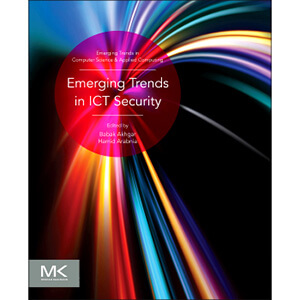Emerging Trends In ICT Security
 BOOK DESCRIPTION:
BOOK DESCRIPTION:
Emerging Trends in ICT Security, an edited volume, discusses the foundations and theoretical aspects of ICT security; covers trends, analytics, assessments and frameworks necessary for performance analysis and evaluation; and gives you the state-of-the-art knowledge needed for successful deployment of security solutions in many environments. Application scenarios provide you with an insider’s look at security solutions deployed in real-life scenarios, including but limited to smart devices, biometrics, social media, big data security, and crowd sourcing.
Provides a multidisciplinary approach to security with coverage of communication systems, information mining, policy making, and management infrastructures
Discusses deployment of numerous security solutions, including, cyber defense techniques and defense against malicious code and mobile attacks
Addresses application of security solutions in real-life scenarios in several environments, such as social media, big data and crowd sourcing
Table of Contents
PART 1: INFORMATION AND SYSTEMS SECURITY
SECTION 1: Theory/Reviews of the field
Chapter 1. System Security Engineering for Information Systems
Chapter 2. Metrics and Indicators as Key Organizational Assets for ICT Security Assessment
Chapter 3. A Fresh Look at Semantic Natural Language Information Assurance and Security
SECTION 2: Methods
Chapter 4. An Approach to Facilitate Security Assurance for Information Sharing and Exchange in Big-Data Applications
Chapter 5. Gamification of Information Security Awareness Training
Chapter 6. A Conceptual Framework for Information Security Awareness, Assessment, and Training
Chapter 7. Security Projects for Systems and Networking Professionals
SECTION 3: Case study
Chapter 8. Assessing the Role of Governments in Securing E-Business
PART 2: NETWORK AND INFRASTRUCTURE SECURITY
SECTION 4: Theory Reviews of the field
Chapter 9. A Survey of Quantum Key Distribution (QKD) Technologies
Chapter 10. Advances in Self-Security of Agent-Based Intrusion Detection Systems
Chapter 11. Secure Communication in Fiber-Optic Networks
SECTION 5: Methods
Chapter 12. Advanced Security Network Metrics
Chapter 13. Designing Trustworthy Software Systems Using the NFR Approach
Chapter 14. Analyzing the Ergodic Secrecy Rates of Cooperative Amplify-and-Forward Relay Networks over Generalized Fading Channels
Chapter 15. Algebraic Approaches to a Network-Type Private Information Retrieval
Chapter 16. Using Event Reasoning for Trajectory Tracking
Chapter 17. Resource-Efficient Multi-Source Authentication Utilizing Split-Join One-Way Key Chain
Chapter 18. Real-time Network Intrusion Detection Using Hadoop-Based Bayesian Classifier
Chapter 19. Optimum Countermeasure Portfolio Selection
Chapter 20. CSRF and Big Data
Chapter 21. Security through Emulation-Based Processor Diversification
Chapter 22. On the Use of Unsupervised Techniques for Fraud Detection in VoIP Networks
PART 3: MOBILE AND CLOUD COMPUTING
SECTION 6: Reviews of the field
Chapter 23. Emerging Security Challenges in Cloud Computing, from Infrastructure-Based Security to Proposed Provisioned Cloud Infrastructure
SECTION 7: Methods
Chapter 24. Detection of Intent-Based Vulnerabilities in android Applications
PART 4: CYBER CRIME AND CYBER TERRORISM
SECTION 8: Theory
Chapter 25. A Quick Perspective on the Current State in Cybersecurity
Chapter 26. A Paradigm Shift in Cyberspace Security
SECTION 9: Methods
Chapter 27. Counter Cyber Attacks By Semantic Networks
Chapter 28. Man-in-the-Browser Attacks in Modern Web Browsers
Chapter 29. Improving Security in Web Sessions
Chapter 30. Leveraging Semantic Web Technologies for Access Control
Chapter 31. Cyber Security Education
SECTION 10: Case study
Chapter 32. Surveillance without Borders
PART 5: FOCUS TOPICS: FROM ONLINE RADICALISATION TO ONLINE FINANCIAL CRIME
SECTION 11: Theory
Chapter 33. A Framework for the Investigation and Modeling of Online Radicalization and the Identification of Radicalized Individuals
Chapter 34. Preventing Terrorism Together
SECTION 12: Methods
Chapter 35. Investigating Radicalized Individual Profiles through Fuzzy Cognitive Maps
Chapter 36. Financial Security against Money Laundering
Chapter 37. Intelligent Banking XML Encryption Using Effective Fuzzy Logic
BOOK DETAILS
Hardcover: 650 pages
Publisher: Morgan Kaufmann; 1 edition (November 2013)
Language: English
ISBN-10: 0124114741
ISBN-13: 978-0124114746



